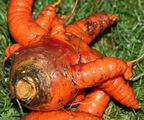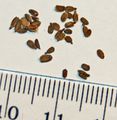Difference between revisions of "Carrot"
From eagle-rock.org
| Line 11: | Line 11: | ||
File:Winter carrot and onion after frost 120217.JPG|Winter carrot and a left-over [[onion]] after frost in winter. They both seem undamaged. | File:Winter carrot and onion after frost 120217.JPG|Winter carrot and a left-over [[onion]] after frost in winter. They both seem undamaged. | ||
File:KarottenZwiebeln 266.JPG|Companion planting of carrots and onions | File:KarottenZwiebeln 266.JPG|Companion planting of carrots and onions | ||
| − | + | File:Daucus carota Sturm12033.jpga | |
</gallery> | </gallery> | ||
Revision as of 06:27, 7 June 2012
Chunks of information
- Carrots can be affected by carrot flies. Crop damage is caused by the up to 10 mm long larvae (maggots) feeding on the outer layers of the carrot root. Onions can be affected by onion flies which resemble houseflies. They lay their eggs in groups on the shoots, leaves and bulbs of host plants and on the ground nearby. The larvae create large cavities in bulbs. But onion flies don't seem to like the smell of carrots and carrot flies don't like onions. So onions and carrots make perfect companion plants. I always plant bulb onions in the lines of carrot seeds, each one or two hand widths an onion. I've never had problems with either carrot flies or onion flies but heard of many gardeners who had this problem. This method also has the advantage that you can see where you sowed the carrots. Carrots take long to germinate but bulb onions sprout fast.
Gallery
Winter carrot and a left-over onion after frost in winter. They both seem undamaged.
- Daucus carota Sturm12033.jpga






